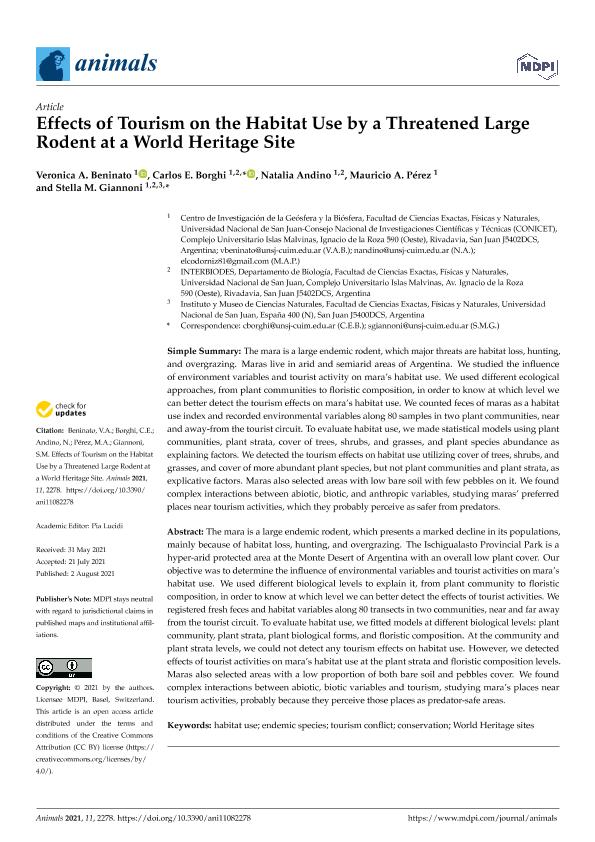Artículo
Effects of Tourism on the Habitat Use by a Threatened Large Rodent at a World Heritage Site
Beninato Bustamante, Veronica Alejandra ; Borghi, Carlos Eduardo
; Borghi, Carlos Eduardo ; Andino, Natalia del Pilar
; Andino, Natalia del Pilar ; Pérez, Mauricio Armando
; Pérez, Mauricio Armando ; Giannoni, Stella Maris
; Giannoni, Stella Maris
 ; Borghi, Carlos Eduardo
; Borghi, Carlos Eduardo ; Andino, Natalia del Pilar
; Andino, Natalia del Pilar ; Pérez, Mauricio Armando
; Pérez, Mauricio Armando ; Giannoni, Stella Maris
; Giannoni, Stella Maris
Fecha de publicación:
08/2021
Editorial:
MDPI
Revista:
Animals
ISSN:
2076-2615
e-ISSN:
2076-2615
Idioma:
Inglés
Tipo de recurso:
Artículo publicado
Clasificación temática:
Resumen
The mara is a large endemic rodent, which presents a marked decline in its populations, mainly because of habitat loss, hunting, and overgrazing. The Ischigualasto Provincial Park is a hyper-arid protected area at the Monte Desert of Argentina with an overall low plant cover. Our objective was to determine the influence of environmental variables and tourist activities on mara’s habitat use. We used different biological levels to explain it, from plant community to floristic composition, in order to know at which level we can better detect the effects of tourist activities. We registered fresh feces and habitat variables along 80 transects in two communities, near and far away from the tourist circuit. To evaluate habitat use, we fitted models at different biological levels: plant community, plant strata, plant biological forms, and floristic composition. At the community and plant strata levels, we could not detect any tourism effects on habitat use. However, we detected effects of tourist activities on mara’s habitat use at the plant strata and floristic composition levels. Maras also selected areas with a low proportion of both bare soil and pebbles cover. We found complex interactions between abiotic, biotic variables and tourism, studying mara’s places near tourism activities, probably because they perceive those places as predator-safe areas.
Archivos asociados
Licencia
Identificadores
Colecciones
Articulos(CCT - SAN JUAN)
Articulos de CENTRO CIENTIFICO TECNOLOGICO CONICET - SAN JUAN
Articulos de CENTRO CIENTIFICO TECNOLOGICO CONICET - SAN JUAN
Articulos(CIGEOBIO)
Articulos de CENTRO DE INVESTIGACIONES DE LA GEOSFERA Y BIOSFERA
Articulos de CENTRO DE INVESTIGACIONES DE LA GEOSFERA Y BIOSFERA
Citación
Beninato Bustamante, Veronica Alejandra; Borghi, Carlos Eduardo; Andino, Natalia del Pilar; Pérez, Mauricio Armando; Giannoni, Stella Maris; Effects of Tourism on the Habitat Use by a Threatened Large Rodent at a World Heritage Site; MDPI; Animals; 11; 8; 8-2021; 1-11
Compartir
Altmétricas



